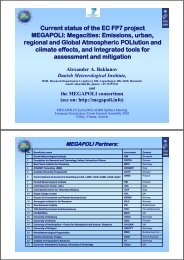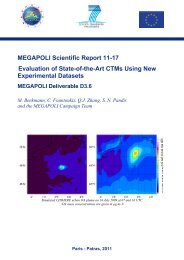D E S C R I P T I O N O F W O R K - MEGAPOLI - Dmi
D E S C R I P T I O N O F W O R K - MEGAPOLI - Dmi
D E S C R I P T I O N O F W O R K - MEGAPOLI - Dmi
You also want an ePaper? Increase the reach of your titles
YUMPU automatically turns print PDFs into web optimized ePapers that Google loves.
<strong>MEGAPOLI</strong> 212520<br />
Local/urban<br />
~1-10 2 km<br />
Megacities<br />
Emissions<br />
Boundary Layer<br />
Processes and Chemical<br />
Transformations<br />
Urban Features and<br />
Characteristics<br />
Regional<br />
~ 10 3 km<br />
Air Quality<br />
Figure 2: Schematic showing the main linkages between megacities, air quality and climate. The<br />
connections and processes will be the focus of <strong>MEGAPOLI</strong>. In addition to the overall connections between<br />
megacities, air quality and climate, the figure shows the main feedbacks, ecosystem, health and weather<br />
impact pathways, and mitigation routes which will be investigated in <strong>MEGAPOLI</strong>. The relevant temporal<br />
and spatial scales are additionally included.<br />
and will also, through an understanding of the sensitivity of emissions of different compounds and<br />
from different sectors, form the basis for sensible approaches to mitigation strategies. This task will<br />
use as a starting point the corresponding emission inventories developed by local administrations<br />
for major urban areas. These will be improved when necessary, adjusted to the appropriate model<br />
scale and integrated into larger scale datasets for their use in regional and global scale atmospheric<br />
composition modelling. This approach will allow the exploitation of former investments and<br />
available information, and will build connections between local air quality management authorities<br />
and the air quality and climate research community. Emissions are the focus of WP1 in the project,<br />
and its links to the other aspects of the project as shown in Figure 3. WP2 is focusing on the<br />
megacity features (e.g. morphology), along with processes taking place in the urban canopy and<br />
boundary layer, which are responsible for the airborne transport and transformation of pollutants<br />
10<br />
Forcing<br />
Global<br />
~10 4 km<br />
Climate<br />
1 s - 1 hr Days - weeks Years-decades<br />
Connections<br />
Processes<br />
Impacts<br />
Mitigation<br />
Chemical<br />
Transformations<br />
Feedbacks<br />
Scales




